Butterzopf is a classic Swiss bread which is often served for weekend brunches. Try this Butterzopf recipe with step-by-step photos.
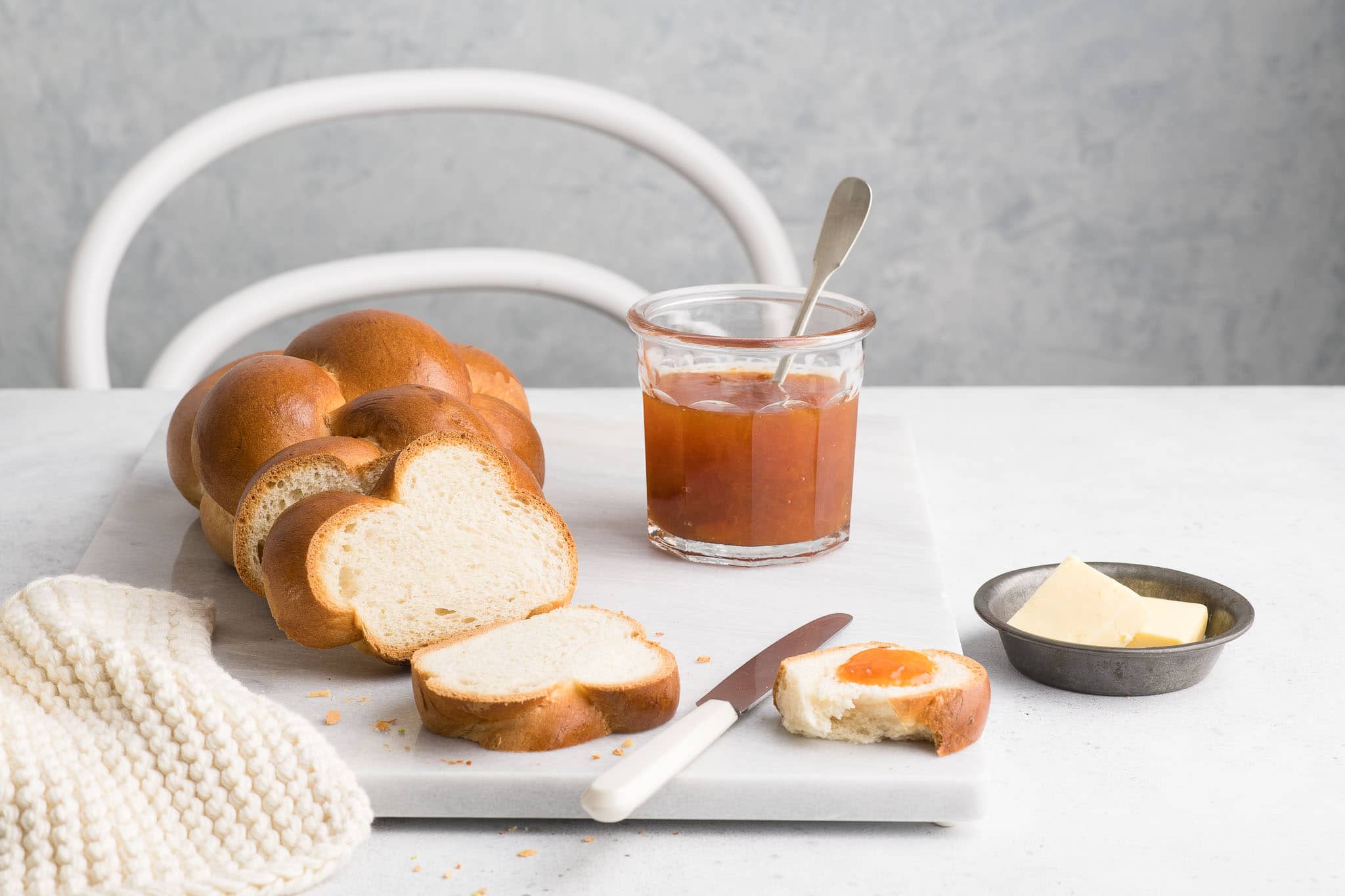
What is Butterzopf?
In Switzerland, it is a ritual in most households to serve a loaf of Butterzopf for breakfast on the weekends, so much so that many bakeries do not even sell these loaves during the week.
A Butterzopf (also known as Zopf, Tresse, Treccia – depending on where you are in Switzerland), is an enriched plaited white bread.
In German, Zopf simply means a plait. And a Butterzopf means that the bread contains, of course, butter.
The main difference between a Butterzopf and Jewish challah is that a Butterzopf contains butter, whereas challah traditionally uses oil.
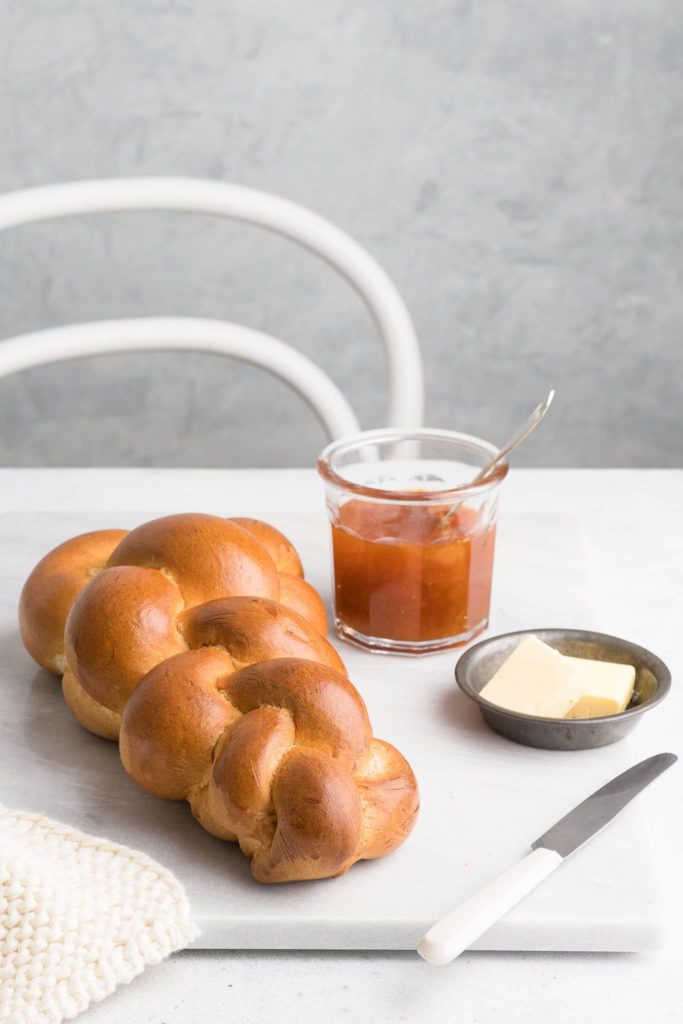
Swiss National Day Celebration
The Swiss celebrate their National Day on 1 August, and it is customary to gift a Zopf or similar bread on this day.
You can find Butterzopf in all supermarkets and bakeries in Switzerland, and they come in a variety of sizes.
Some bakeries even make them by the metre! But they are sold in large portions from this giant loaf, and which is ideal if you happen to be someone who doesn’t like the crusty end pieces. They are also perfect for small households who don’t eat a lot of Zopf.
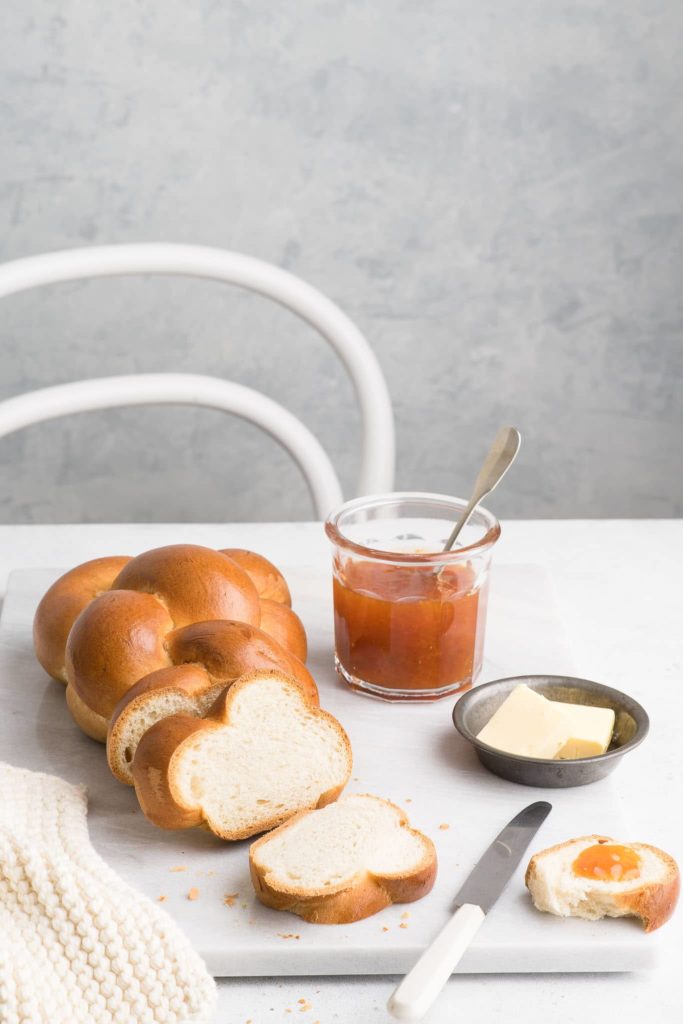
How to Serve Butterzopf
Butterzopf is best when it is served fresh.
It is traditionally sliced and served with jam and a variety of hard cheese (Swiss, of course!).
I’m rather impartial to a chocolate hazelnut spread, and I also happen to love it spread with some butter (you can never have too much) and Vegemite!
Any day-old Zopf happens to be lovely lightly toasted.
How to Make Butterzopf
Step 1
Measure the flour, salt, sugar and yeast into the bowl of an electric stand mixer.
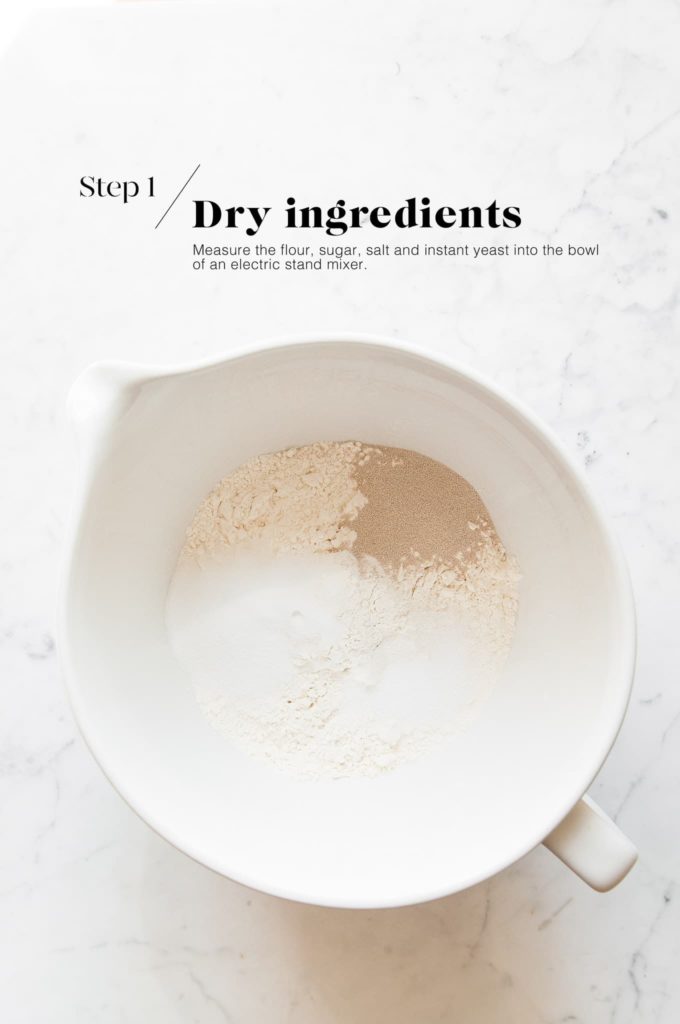
Step 2
Slowly add the warm milk, and mix everything together with the dough hook until the mixture comes together into a ball of dough.
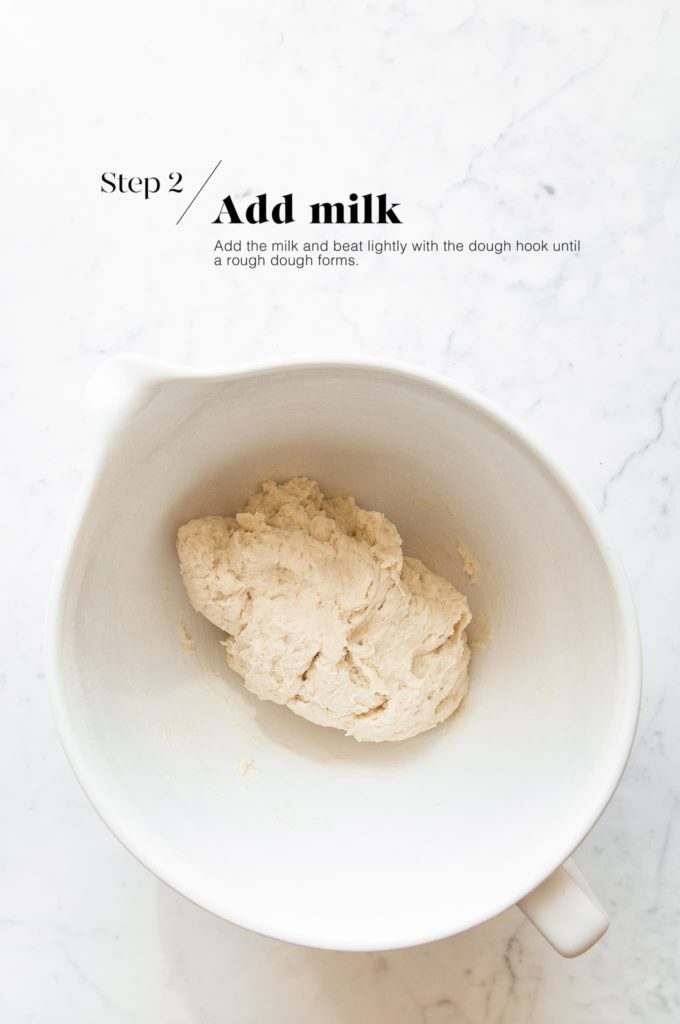
Step 3
Add the butter, one tablespoon at a time. Once the butter is fully incorporated into the dough, add the next tablespoon of butter.
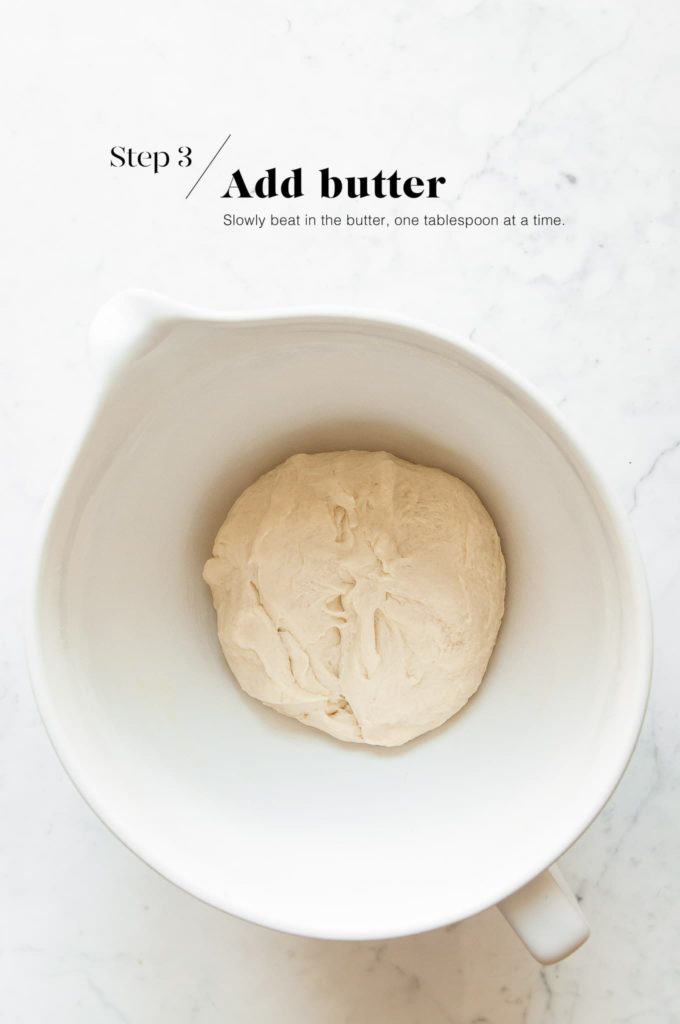
Step 4
Once all of the butter has been added, continue to knead the dough on low-medium speed (or KitchenAid speed 2) for 10 to 15 minutes, or until the dough is smooth and elastic in texture.
Place the dough into a lightly oiled mixing bowl and cover with a clean tea towel.
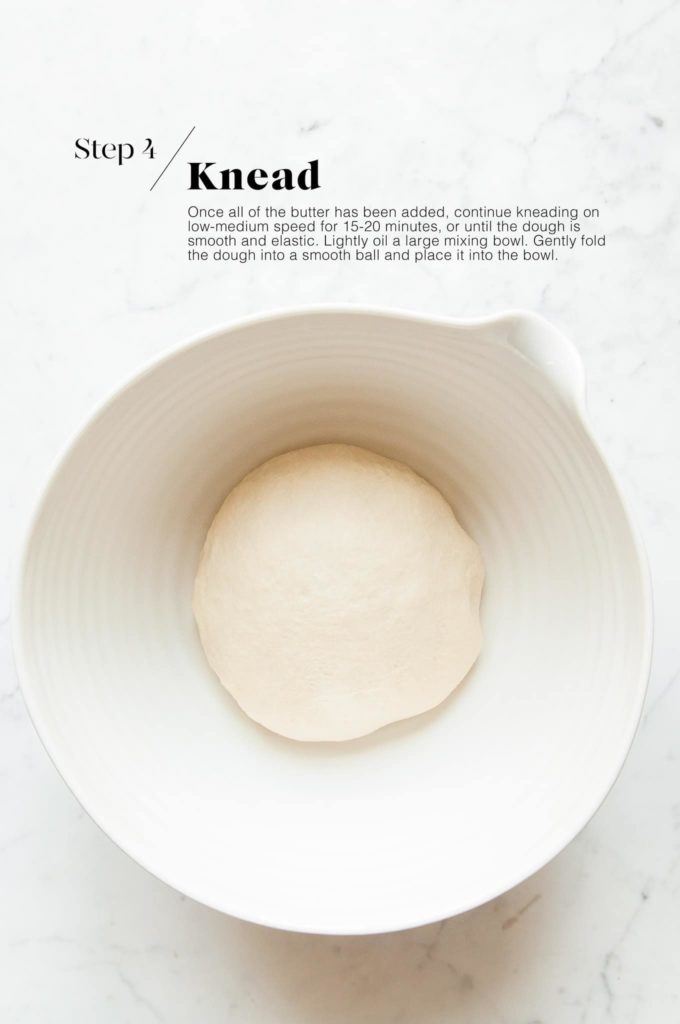
Step 5
Place the dough somewhere warm for about 1 to 1.5 hours, or until the dough has doubled in size.
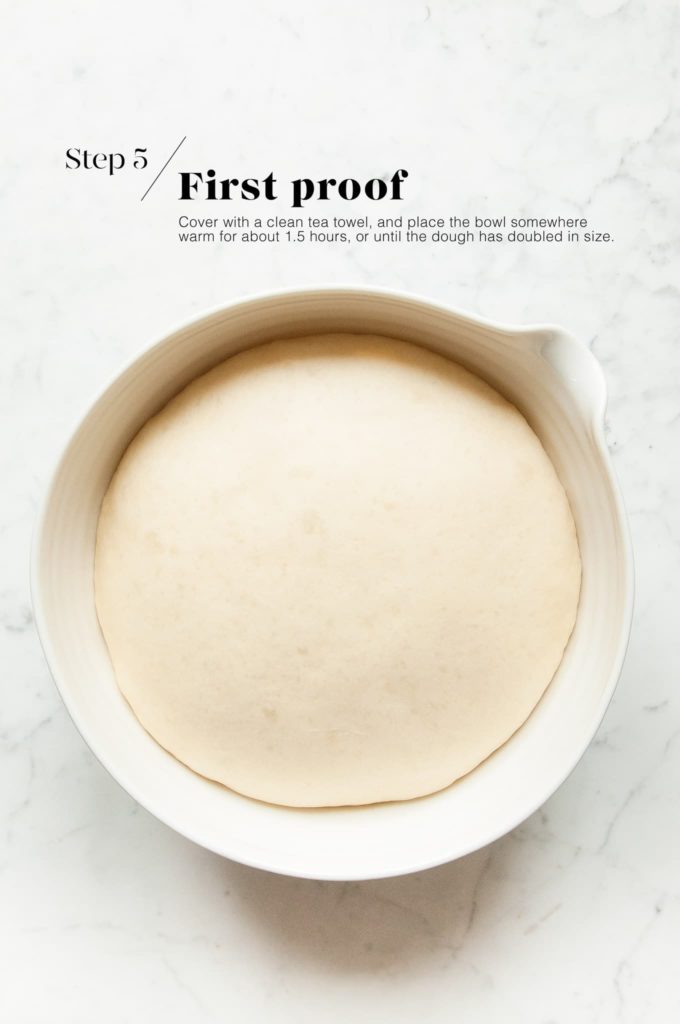
Step 6
Gently remove the dough from the bowl – it will deflate as you handle it.
Separate the dough into two pieces and roll each piece into a long log, measuring approximately 70 cm (2.5 feet). Try to taper the ends so they are thinner than the middle section of the dough.
To prepare a traditional Butterzopf braid, follow the diagrams below.
Alternatively, you can do a more common braid by splitting the dough into three pieces.
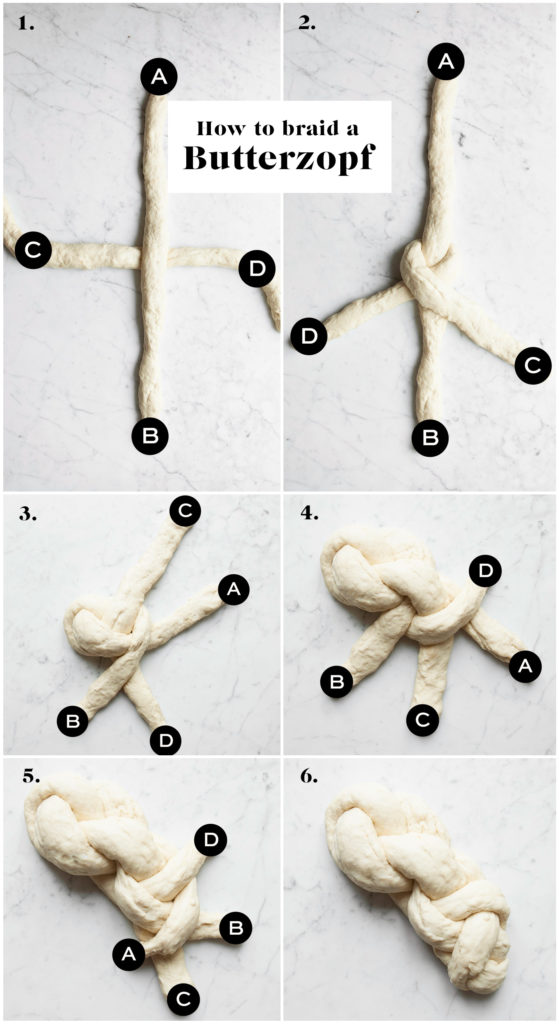
Step 7
Once the bread has been shaped, cover it with a clean tea towel and leave it somewhere warm for about 30 minutes for it to rise and puff up slightly.
When you are ready to bake the bread, brush the bread with some egg wash. Bake for about 35 minutes, or until the bread is golden brown. An internal thermometer should read approx 85°C (185°F).

More Swiss Recipes
If you are looking for more Swiss recipes, you might also like:
Zurich-Style Veal with Creamy Mushroom Sauce (Zürcher Geschnetzeltes)
PrintButterzopf

- Resting Time: 2 hours
- Prep Time: 3 hours
- Cook Time: 35 mins
- Total Time: 3 hours 35 minutes
- Yield: Makes 1 loaf
- Category: Bread
- Method: Oven
- Cuisine: Swiss
Butterzopf is a classic Swiss bread which is often served for weekend brunches. Try this Butterzopf recipe with step-by-step photos.
Ingredients
For the Butterzopf
- 500 g (3 1/3 cups) white bread flour
- 1 teaspoon fine salt
- 2 tablespoons caster sugar (superfine sugar)
- 7 g (2 teaspoons) instant dried yeast (see Kitchen Notes below)
- 60 g (4 tablespoons) unsalted butter, softened
- 300 ml (1 cup plus 3 tablespoons) milk, warmed to 37°C (98°F)
For the Egg Wash
- 1 egg
- 1 tablespoon milk
Instructions
You will need approx 3.5 hours to make the Butterzopf
To make the dough
- Measure the flour, sugar, salt and yeast into the bowl of an electric stand mixer.
- Lightly mix the ingredients together using the dough hook.
- Slowly pour in the warm milk, and continue mixing until everything comes together into a rough dough.
- Add the butter, one tablespoon at a time. Once the butter has been fully incorporated into the dough, add the next tablespoon of butter.
- Once all of the butter has been added, continue kneading the dough on low-medium speed for about 15 to 20 minutes.
- The dough is ready when it is soft and smooth, and also slightly elastic in texture when you try to stretch it. If you poke the dough softly, it should bounce back right away.
- Lightly oil a large mixing bowl.
- Place the dough inside the bowl.
- Cover the dough with a clean tea towel.
- Leave the dough somewhere warm for 1 to 1.5 hours, or until the dough has doubled in size (see Kitchen Notes below).
To shape the dough
- Once the dough has doubled in size, gently remove the dough from the bowl. The dough will deflate as you handle it.
- Divide the dough into two pieces, and roll each piece into a long log, measuring approximately 70 cm (2 feet) long. Try to taper the ends so that they are slightly thinner than the middle section of the logs.
- Arrange the two strands of dough on your work surface so that they form a cross or plus symbol.
- Plait the strands of dough as indicated in the photos above. Alternatively, divide the dough into three pieces and do a traditional plait with three strands of dough.
- Carefully transfer the plaited dough onto a sheet of baking paper.
- Place the dough somewhere warm for about 30 minutes, or until the dough has risen and puffed up slightly.
To bake the dough
- Preheat the oven to 220°C (428°F).
- Place a metal baking tray in the middle shelf of the oven while it is preheating.
- Make the egg wash by lightly whisking together the egg and milk.
- Brush the dough with some egg wash.
- Bake for about 35 minutes, or until the bread is lightly golden. The bread is cooked if an internal thermometer reads 85°C (185°F).
- Transfer the bread to a wire rack and let it cool before serving.
Kitchen Notes
 DIFFERENT TYPES OF FLOUR
DIFFERENT TYPES OF FLOUR
* For Swiss readers: I use Zopfmehl (or farine pour tresse) when making bread and enriched dough.
 DIFFERENT TYPES OF YEAST
DIFFERENT TYPES OF YEAST
* Please note that there is a difference between instant yeast (also called instant dried yeast or fast-action dried yeast) and dried yeast (also called active dry yeast). If you are not sure what type of yeast you have, please check the packaging for instructions on how to use the yeast.
* With instant yeast, you can add it directly to the flour mixture without having to activate it first.
* With dried yeast, you will need to activate it first (usually in some warm liquid).
* If you are using fresh yeast, you will need about half a block (20 g fresh yeast = 7 g instant dried yeast = 2 teaspoons instant dried yeast). Crumble the fresh yeast into the warm milk, and stir to dissolve the yeast.
 PROOFING THE DOUGH
PROOFING THE DOUGH
Dough needs a warm environment for the yeast to activate and cause the dough to rise. If you don’t have a warm place in your home, try one of the following ideas:
* In the oven with the oven light switched on (works only for some ovens).
* In the oven with a tray of boiling water on the bottom shelf.
* In the oven at a low temperature of about 25-30°C (77-86°F).
* On the open oven door, with the oven turned on at 100°C (212°F).
 OVEN TEMPERATURES
OVEN TEMPERATURES
All recipes on this website state temperatures for a regular oven (i.e. a conventional oven without fan). If you have a convection oven with a fan, please consult the manufacturer’s handbook on how to adjust the temperature and baking time accordingly.
 CONVERSIONS
CONVERSIONS
To convert from cups to grams, and vice-versa, please see this handy Conversion Chart for Basic Ingredients.
 Print
Print Pin Recipe
Pin Recipe Rate
Rate

Hello, I just moved to Switzerland and am confused by the yeasts. What is Trockenhefe (Belbake) versus Hefe (Dr. Oetker)? I’m trying to figure out instant vs regular yeast for baking and just ran out of the yeast I brought from the states. Google searches are not helping very much 🙂
Hi Anna,
Welcome to Switzerland! “Trockenhefe” is dried yeast. You will have to check the back of the packet to see if it is instant yeast (which you can add directly to the dry ingredients) or if it is active dried yeast or the “non-instant” variety (which you have to activate first in some warm water). Most brands have instructions on the back on how to use the yeast, and this will tell you what type of dried yeast you have.
“Backhefe” or fresh yeast are sold in cubes in the refrigerated sections of the supermarket, usually where you find the ready-made puff pastry and bread rolls.
Hope this helps! Feel free to email me a photo of the packaging if you need some help with the translation 😊
Tolles Rezept! Herzlichen Dank 🙂
Lovely
Delicious! I have made this a few times for brunch with my family. My grandmother is Swiss and she is always so pleased to see this Butterzopf.
Was looking for the english version of the Zopf-recipe to mail to some of my us-friends and came across your page. Thank you for making the effort to post such thorough instructions. As a Swiss who grew up making Zopf and continues to do so, I am taking the liberty to add just one comment to perfect your skills:
we never ever punch down the dough!!!! I have never seen or read this in any Swiss Zopf recipe. I was taught that punching down the dough would make the bread too dense which is not what you want with a Zopf. Let the dough rise and once doubled go straight to braiding the bread. Some let it rise another 30mins before brushing it with the yolk and baking.
Hello!
Thank you for your comment 🙂 That is quite interesting that you don’t punch down the dough. It’s something that I used to do for all bread recipes, except for pizza dough, because I only give pizza dough one proofing session. However, recently, I find that I prefer to handle the dough more gently when I am making bread, perhaps as a result of my pizza making experiences. So there could be some truth in the Swiss method! I will update my recipe here 🙂
So instead of punching down the dough (which I do gently, anyway), I push the dough down softly into a ball, before handling it as per the recipe. However, for braiding dough, I find that you do need to knock out some of the air to make the braiding easier. But I suspect that you must be more expert at braiding the dough quickly than I am 😉